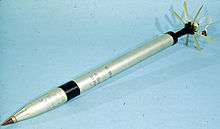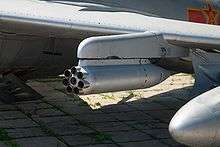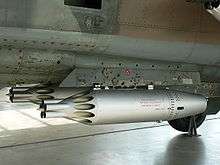S-5 rocket

The S-5 (first designated ARS-57) is a rocket weapon developed by the Soviet Air Force and used by military aircraft against ground area targets. It is in service with the Russian Air Force and various export customers.
It is produced in a variety of subtypes with different warheads, including HEAT anti-armour (S-5K), high-explosive fragmentation (S-5M/MO), smoke, and incendiary rounds. Each rocket is about 1.4 meters (4 ft 6 in) long and weighs about 5 kg (11 lb), depending on warhead and fuze. Range is 3 to 4 kilometres (1.9 to 2.6 miles).
Development
Developed in early 1950s,[1] originally as part of the air-to-air AS-5 weapon system for the MiG-19. The rockets were tested in a series of configurations on MiG-15bis and MiG-17 jets, with the final tests complete on a MiG-17PF in January 1955. The tests revealed that the rockets did not perform as expected against aerial targets. The rocket ARS-57 was accepted into service in April 1955, with a military designation S-5.[1]
Apart from the Soviet Union and then Russia, S-5 rockets were produced among others in Poland.[2] As of 2013, the only producers remained Belarus and Bulgaria.[2]
Description


The S-5 is a 55 mm (2.2 in) calibre unguided rocket fired from a 57 mm calibre tube. It is used by fighter bombers and helicopters. It consists of a steel body containing a solid fuel rocket, and a high-explosive warhead with a mechanical impact fuse. At the rear of the rocket is an elongated exhaust nozzle, with eight attached forward folding wings. The fins fold around the rocket when it is stowed in its launch tube, springing back as soon as it leaves the launch tube. In flight, the fins provide a stabilizing spin to the rocket, turning at approximately 750 rpm. The solid rocket motor burns for just 1.1 seconds, during which time it covers about 300 meters (985 ft).
The S-5 is carried in rocket pods, with 4–32 rockets. The first were ORO-57 launchers, made in variants with capacity of 4, 8 and 16 rockets. Most typical became ORO-57K for 8 rockets, used especially with MiG-19. Then, beginning in the early 1960s, the typical launcher became UB-16-57, with 16 rockets, developed in several variants, for helicopters and planes. UB stands for "universal block", as it could be carried on conventional bomb hardpoints, "57" refers to the actual diameter of the launch tube (the diameter of the rocket plus 2 mm). The first variant and UB-16-57U had a conical forward part while the next variant UB-16-57D had a blunt forward part. Starting in 1968, a variant UB-16-57UMP was produced, with a conical forward part and five protruding inner tubes.[1] In the 1970s, UB-32 was developed with 32 rockets, carried by heavier aircraft. In Poland, Mars-2 launcher was developed for 16 rockets, and in Romania, LPR 57 launchers for 16 rockets.
Operational history
Afghanistan
S-5 rockets were used extensively by Sukhoi Su-25 and Mil Mi-24 aircraft in Afghanistan in the 1980s, where their effectiveness was considered poor. Pilots described the rockets fanning out after launch "like a tulip", and that the warhead was only good for "tickling the dookhi's (mujahedeen) heels". The Russian forces have shifted to higher-calibre weapons like the S-8 rocket instead. In addition the Soviet 40th Army made use of improvised launchers mounted on T-62 tanks, BTR-70 APCs and Ural-4320 trucks in a ground-to-ground role.[3]
Israel
On Sunday, 6 January 2009, The Israel Defense Forces identified a rocket fired at Israel earlier in the day by militants in the Gaza Strip as a Russian-made S5K, the type used in battle in Iran and Afghanistan.
According to the IDF, the rocket fired at Kibbutz Alumim in the Negev marked the first time militants in Gaza have used this type of weapon. Although the weapon is intended to be launched aerially, Gaza militants chose to launch their rocket from ground-based launchers. Unlike a Qassam rocket, the S5K contains more explosives, but is less precise.
On Friday, 8 December 2017, two S-5 rockets fired from Gaza Strip, landed on Sderot. One of the rockets landed on a kindergarten and the second one landed on a nearby street, causing damage to a car.
Libya
S-5, along with S-8 and S-13 rockets, have been deployed from the backs of pick-up trucks (generally, technicals) during the 2011 Libyan civil war,[4] serving as a makeshift MLRS. The rebels have also developed a man-portable launcher for the S-5, turning the rocket into a makeshift RPG round.[4]
Syria
The S-5 has seen use by the Syrian Air Force against opposition forces in the Syrian civil war.[5]
Typical launchers specifications

Rocket specifications
| Designation | Type | Length overall | Launch weight | Warhead weight | Notes |
|---|---|---|---|---|---|
| S-5 | GP | 0.915 m | 3.99 kg | 1.16 kg | Impact fuze |
| S-5M | HE-FRAG | ? | ? | ? | Produces 75 splinters |
| S-5M1 | HE-FRAG | 0.882 m | 3.86 kg | 0.8 kg | Produces 75 splinters |
| S-5MO | Frag | 0.998 m | 4.82 kg | 0.8 kg | Warhead has 20 notched steel rings generate 360 fragments. |
| S-5K | HEAT | ? | ? | ? | Shaped charge warhead, 130 mm versus RHA. |
| S-5K1 | HEAT | 0.83 m | 3.64 kg | 1.1 kg | Shaped charge warhead, 130 mm versus RHA. |
| S-5KO | HEAT / FRAG | 0.987 m | 4.43 kg | 1.36 kg | Warhead has 10 notched steel rings, 220 fragments. |
| S-5KP | HEAT / FRAG | ? | ? | ? | Shaped charge with wound wire fragmentation jacket and sensitive piezoelectric impact fuze. |
| S-5KPB | HEAT / FRAG | 1.079 m | 5.01 kg | 1.8 kg | Shaped charge with wound wire fragmentation jacket and sensitive piezoelectric impact fuze. |
| S-5S | Flechette | ? | ? | ? | Warhead contains 1,000 to 1,100 40 mm long flechettes. |
| S-5SB | Flechette | ? | ? | ? | Warhead contains 1,000 to 1,100 40 mm long flechettes. |
| S-5P (PARS-57) | Chaff | ? | ? | n/a | Chaff rocket |
| S-5P1 | Chaff | 1.073 m | 5.04 kg | n/a | Chaff rocket. |
| S-5-O | Flare | ? | ? | ? | Flare / illumination |
| S-5-O1 | Paraflare | 0.948 m | 4.94 kg | 1.73 kg | Parachute flare. |
| Wikimedia Commons has media related to S-5 rocket. |
See also
- UB-32, the rocket pod that fires the S-5
- RS-82 rocket
- S-8 rocket
- Ugroza, a proposed upgrade of "dumb" rockets to salvo-fired laser-guided precision missiles
References
- 1 2 3 (in Russian) C-5 at Ugolok Neba site
- 1 2 17 tys. S-5 dla WP, altair.com (in Polish) published 2013-05-29 [access 2017-10-13]
- ↑ , Lyamin & Jenzen-Jones 2014, p. 11 & 12
- 1 2 , Lyamin & Jenzen-Jones 2014, p. 19
- ↑ Lyamin & Jenzen-Jones 2014, p. 22
- 1 2 3 (in Polish)Tomasz Szulc, Następcy Katiuszy. Cz.II in: nowa Technika Wojskowa nr 8/98, ISSN 1230-1655
- Soviet/Russian Aircraft Weapons Since World War Two, Yefim Gordon, ISBN 1-85780-188-1
- Mil Mi-24 Hind Attack Helicopter, Yefim Gordon and Dimitri Komissarov, ISBN 1-84037-238-9
- Jane's Air Launched Weapons Issue 36, Duncan Lennox, ISBN 0-7106-0866-7
- IDF: Gaza militants fired new kind of rocket at Israel, Haaretz Service,
- Lyamin, Yuri; Jenzen-Jones, N.R. (2014). Improvised Employment of S-5 Air-To-Surface Rockets in Land Warfare: A Brief History and Technical Appraisal (PDF). Armaments Research Services. ISBN 978-0-9924624-0-6.
External links
- "Libya Conflict". PPrune Forum. 2011-04-10.
- Libya rebels make weapons from scraps on YouTube
- War Time Inventions Pt 3 - Shoulder-Fired S-5 Missiles on YouTube